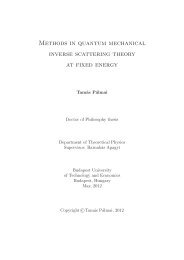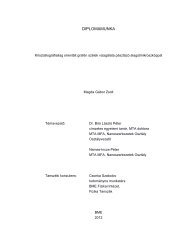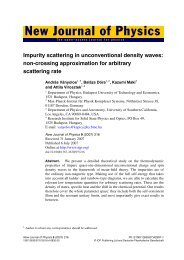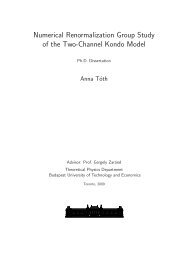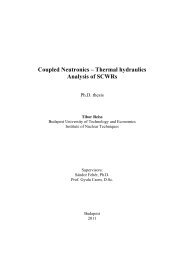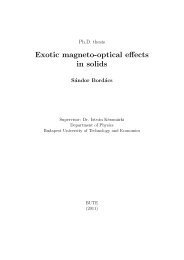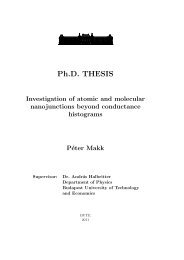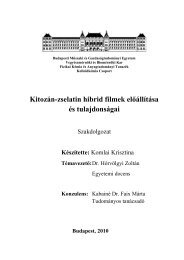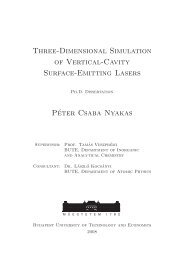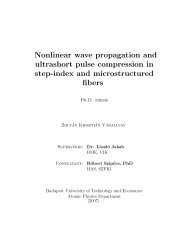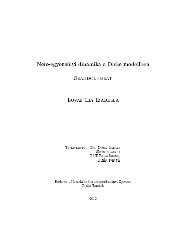Ph.D. THESIS Multipolar ordering in f-electron systems
Ph.D. THESIS Multipolar ordering in f-electron systems
Ph.D. THESIS Multipolar ordering in f-electron systems
You also want an ePaper? Increase the reach of your titles
YUMPU automatically turns print PDFs into web optimized ePapers that Google loves.
Chapter 3 Octupolar Order<strong>in</strong>g of Γ 8 Ions 45<br />
the ground state moments do not depend on the coupl<strong>in</strong>g strengths:<br />
q t→0 = B, and T t→0 = A.<br />
• large-j limit<br />
The first <strong>in</strong>stability occurs now when the coefficient of the q 2 term<br />
changes sign, and pure quadrupolar order sets <strong>in</strong> at t quad = B 2 j. This<br />
critical l<strong>in</strong>e meets the boundary of first-order transitions at the critical<br />
end po<strong>in</strong>t j end ≈ 2.75, t end ≈ 177 (Fig. 3.3). For j > j end there are<br />
two phase transitions: the onset of pure quadrupolar order is followed<br />
by the emergence of mixed octupolar–quadrupolar order at t oc . The<br />
lower phase transition is of first order up to the second tricritical po<strong>in</strong>t<br />
j tri,2 ≈ 3.75, t tri,2 ≈ 185. For j < j tri,2 , the onset of octupolar order<br />
is reflected <strong>in</strong> a discont<strong>in</strong>uity of q (see the right part of Fig. 3.4). For<br />
j > j tri,2 , both transitions are cont<strong>in</strong>uous.<br />
We can notice by look<strong>in</strong>g the phase diagram on Fig. 3.3 that the octupolar<br />
transition temperature <strong>in</strong>side the quadrupolar ordered phase<br />
is less and less affected as we <strong>in</strong>crease the value j, and t oc saturates<br />
at a constant value. Though <strong>in</strong> this regime, we cannot use Landau<br />
expansion to determ<strong>in</strong>e q because the assumption that it is small is not<br />
valid, we may assume that it is near its ground state value B, and use<br />
a low-order expansion <strong>in</strong> T to obta<strong>in</strong> <strong>in</strong> the large-j limit<br />
lim t A 2 exp(Bqj/t oc )<br />
oc = lim<br />
j→∞ j→∞ exp(Bqj/t oc ) + exp(−Bqj/t oc ) = A2 ≈ 246 (3.19)<br />
This is an <strong>in</strong>terest<strong>in</strong>g feature of this octupolar–quadrupolar model because<br />
<strong>in</strong> familiar phase diagrams of dipolar–quadrupolar models, the<br />
mixed order would be completely suppressed at J quad /J dipole → ∞ (we<br />
will discuss it <strong>in</strong> detail <strong>in</strong> Section 4.5). In contrast, we f<strong>in</strong>d the f<strong>in</strong>ite<br />
saturation value (3.19) as J quad /J oc → ∞. The reason, as we understood<br />
earlier, is that <strong>in</strong> the Γ 8 subspace the Γ 5 quadrupoles are completely<br />
isotropic. We can also see on Fig. 3.3 that while the octupolar<br />
order <strong>in</strong>duces quadrupoles immediately, it is not true backwards: the<br />
develop<strong>in</strong>g of non-zero quadrupolar moments does not mean the appearance<br />
of the octupoles. We will understand this situation <strong>in</strong> detail<br />
<strong>in</strong> Section 3.4.



